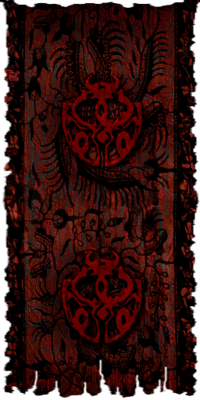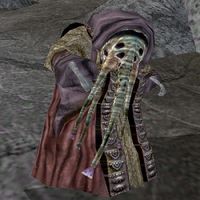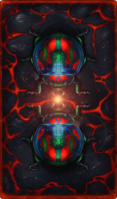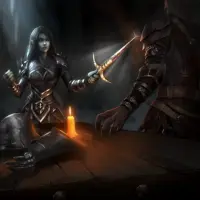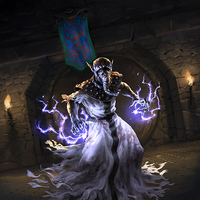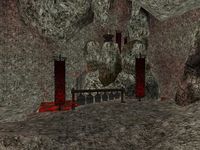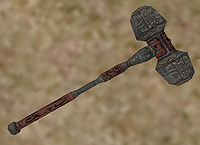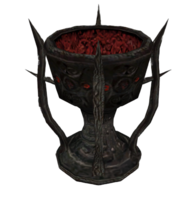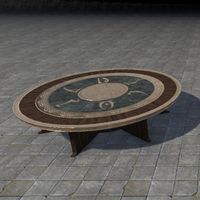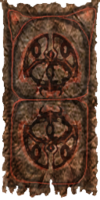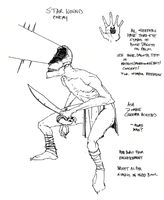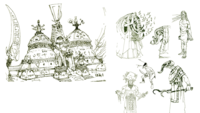Lore:House Dagoth
| To meet our site's higher standard of quality, this article or section may require cleanup. The user who placed this here had the following concern: remove redundancies coverd in other articles, check facts, refs To leave a message about the cleanup for this article, please add it to this article's talk page. |
- 'Pity Dagoth Ur and the Sixth House. All they do, all they are is foul and evil, but they began in brightness and honor, and the cause of their fall was their loyal service to you, Lord Nerevar.' — Peakstar
House Dagoth (also called Clan Dagoth,[1] the Sixth House, Shadow House,[2] Sleeping House,[3] Lost House,[4] Traitor House, House of Lord Dagoth,[5] the Tribe Unmourned[6][7] or "unmourned house")[8][9] is the defunct sixth Great House of the Chimer led by Voryn Dagoth, later known as Dagoth Ur. The lost clan's ancient homeland was swallowed up by what is now Vvardenfell,[1][10] being the only Great House to have their capital, Kogoruhn, located in the region.[11][12] In the First Age, House Dagoth betrayed the other Great Houses and allied with the Dwemer during the War of the First Council (though some sources claim they fought against the Dwemer), being branded a traitor house and was destroyed for their treason.[5] All records of the house's existence were destroyed following the Battle of Red Mountain and its members were either killed or absorbed into the remaining houses.
Unbeknownst to all, Lord Dagoth had survived and spent centuries slowly building his strength and influence from within Red Mountain. This culminated with Dagoth's attempt to re-create the Dwemer god-construct Numidium in order to overthrow the Tribunal and conquer Morrowind.[13] In 3E 427 Dagoth Ur was slain and his plans halted with the destruction of the Heart of Lorkhan by the Nerevarine.[14]
Contents
Early Years[edit]
House Dagoth was founded in ancient times, predating the War of the First Council. They were one of the founding clans of the Grand Council, who collectively control the politics and trade of Morrowind with the other Great Houses.[1] Prior to the War, thirty of the most influential and revered Chimer Clans worked together to build the fabled Library of Andule, a grand repository containing the genealogical records related to the earliest Velothi settlers and other assorted knowledge about the earliest history of the Great Houses.[15] Three of the thirty Revered Families hailed from House Dagoth; the Favel, Ginith, and Rethandus Clans.[16] The locations of the tombs were presumed lost in the aftermath of the War of the First Council, along with the Library of Andule and the records contained within.[15] The six tombs were rediscovered in 2E 582, alongside the other twenty-seven families and the Library of Andule itself.[17]
The War of the First Council[edit]
The first mentions of House Dagoth are recorded in connection to the War of the First Council between the Chimer and the Dwemer. Imperial sources claim that House Dagoth stood with the Dwemer (and identifies both as Chimer clans).[18] However, others with more direct knowledge of the actual events, such as the Ashlander tradition and that of the Tribunal Temple depicts the war as first being prosecuted against the Dwemer by an alliance of all the Great Houses, including Dagoth. By this account, Voryn Dagoth had discovered that the Dwemer, whose king Dumac had been a close friend and ally of the Chimer Hortator Indoril Nerevar, were secretly using the Heart of Lorkhan to build a mechanical god, which was an affront to the Chimer faith. After counseling with Azura, who confirmed Dagoth's story, Nerevar came before Dumac to force the issue. Dumac, however, had no knowledge of this project undertaken by Kagrenac and his tonal architects and responded with hostility to Nerevar's accusations which resulted in war. Disputes over religion divided the Council, with House Dwemer and House Dagoth on one side and all the other Houses on the other. Dumac and Dagoth invited Orc and Nord clans as allies, and held northwest Morrowind, while Nerevar mustered the other Houses and nomad tribes and marched to meet the Dwemer-Dagoth-Westerner forces.[19]
The specifics of what happened after the climactic Battle of Red Mountain are lost to history. By the Ashlander account, Voryn Dagoth wished for the destruction of Kagrenac's Tools, while Nerevar sought counsel with his advisers -- Almalexia, Sotha Sil, and Vivec. The three coveted the power of the Heart and so conspired to obtain the tools by any means, even going so far as to murder Nerevar because he would not go along with their plan. When the three came to Lord Dagoth without Nerevar he refused to hand over the tools, citing his oath to Nerevar to guard them, but was defeated and driven underneath Red Mountain, beneath even the Heart Chamber, and the Tribunal took the tools. The version of the story told by Vivec privately to his priests is somewhat different. Nerevar returned to the mountain with his advisers after deciding that Kagrenac's Tools could be used for good, but Dagoth had already experimented with them and the Heart. He fought against the Tribunal, believing only he could be trusted with the tools. Though this version does not mention how Nerevar died, it is somewhat supported by Dagoth Ur himself who, in a message to the Nerevarine states that it was Nerevar himself who "struck me down."[20][21][22]
Since Dagoth Ur had disappeared, and the rest of his house had been soundly crushed in battle, Great House Dagoth sank into obscurity until the late Second Era. Efforts to resurrect the House were made around 2E 582, but were seemingly unsuccessful.[23]

The Re-awakening[edit]
In the year 2E 882, at the close of the Second Era, Dagoth Ur and his remaining subjects became active again within Red Mountain. Having somehow been kept alive by the power of the Heart, he had spent centuries dreaming and planning. When he arose, he took possession of the Heart Chamber and with unknown rituals, bound himself to the Heart, becoming a heartwight. He also made his nobles into the first of the Ash Vampires, powerful beings who were also bound to the Heart, though not as strongly, who would serve as generals in his coming conquest. In his long sleep, he had adopted the goals of Kagrenac and set about finishing the Dwemer's ill-fated project, hoping to create a new god called Akulakhan for whom his House would serve as the priesthood. In the long term, House Dagoth and its new, immortal masters would conquer all of Tamriel and worship of Akulakhan would become its sole religion.[13]
The first blow was struck that same year when the Almsivi came to Red Mountain for the annual ritual to tap the Heart and renew their powers. Dagoth Ur and his minions ambushed them and drove them from the Heart Chamber. This would prove to be a pivotal event in the history of Morrowind, as the forces of the Temple would never again control the region around Red Mountain, nor would the Tribunal ever regain their full powers. With the initiative in his hands, Dagoth Ur set about expanding the number and influence of his House. To this end, he spread The Blight, terrible ash storms spawned at the center of Red Mountain that carried with them the dreaded Corprus disease which twisted its victims into monsters.[24] Called the "Divine Disease" by the some of the Temple faithful, Corprus is in fact the effect of Dagoth Ur's power on mortal flesh. Those deemed unworthy to the cause it turns into mindless husks, but those with potential to serve it made into Ash Creatures, beings whose bodies and minds are progressively warped by the alien designs of Dagoth Ur. These creatures would go on to promote the interests of the House throughout Vvardenfell, notably by influencing the dreams of some susceptible Dunmer. These "Sleepers" would go into a trance-like state and act as conduits for the thoughts and message of Dagoth Ur, and even act as assassins.[25]
The Sixth House demonstrated a tremendous amount of foresight, and constantly looked towards its long-term goals. While House Dagoth was ideologically expansionist, it was also very slow and methodical in its movements. In more than 400 years of conflict with the Tribunal, House Dagoth hardly expanded from Red Mountain—only to some ancient Dunmer strongholds and smugglers' caves. This was largely due to Dagoth Ur's apprehension of the Empire. He knew that a premature conflict would result in the inevitable defeat of his House, and so shunned open conflict, at least until Akulakhan could be completed.[13]
House Dagoth and the Tribunal[edit]
For the following four hundred years (roughly the first four hundred years of the Third Era), Almsivi sent annual raiding parties of Ordinators and Buoyant Armigers led by the Tribunal in an attempt to capture the Heart Chamber, but they were always unsuccessful and eventually suspended because of heavy losses to the Temple forces. Blight storms became progressively stronger and affected more and more of Vvardenfell, posing a dire threat to its people. In an attempt to contain the Blight, the Almsivi constructed the Great Ghostfence. Maintaining it required a significant amount of power which was increasingly in short supply, as the Tribunal had not had access to the Heart for centuries.[13][26]
Rather than breach the Ghostfence directly, House Dagoth made use of smuggler bases and ships along the Bitter Coast to spread its influence among the populace. With these, they exported idols called Ash Statues, which agents of the House sold and spread around populated areas. These statues seemingly contained some modicum of Dagoth Ur's power, and would corrupt those who were exposed to them consistently.[27]
In 3E 400, Dagoth Uthol took control of the old Dunmer fortress of Kogoruhn and created an underground tunnel leading under the Ghostfence, into Red Mountain, creating an additional avenue for forces and supplies to pass into Vvardenfell.[13]
Several years later in 3E 417, disaster struck the Tribunal when the artifacts Sunder and Keening were lost in an ill-fated expedition to Red Mountain by Almalexia and Sotha Sil. Only the intervention of Vivec saved his two companions, but the tools were lost. Dagoth Odros and Vemyn would hold Sunder and Keening in their respective Dwemer fortresses in the Ashlands for safekeeping.[28] After this defeat, the Tribunal retired to their capitals and there were no more serious offensives against Dagoth's holdings until the coming of the Nerevarine.[13][29]
Dagoth Ur, though he now held Sunder and Keening, lacked Wraithguard to bind them all together. The best he could have done would be to study Sunder and Keening's enchantments and attempt to duplicate them himself. In 3E 426-7, there was a sudden spike in Sixth House cult activity, including the assassinations of several high-profile Imperial sympathizers as well as foreign Imperial citizens living in Vvardenfell.[13] This may have been intended as a challenge to the authority of the Tribunal, or an attempt to further sour relations between the Dunmer and their Imperial suzerain. It's not known whether this had any bearing on Uriel Septim VII's decision to send the would-be Nerevarine to Vvardenfell that same year. Misshapen monsters and diseases called 'blight disease' also continued spreading from Red Mountain, a volcano where the Devil Dagoth Ur and his ash vampires lived.[30]
Culture[edit]
Due to the purge of records associated with House Dagoth, very little is known about its culture and character. One of the few extant documents describes them as "subtle" and having a penchant for diplomacy and subterfuge.[9] This may go some way to explain Dagoth Ur's willingness to take up the failed project of his race's ancient enemy, as well as his seemingly conciliatory attitude towards the Nerevarine.[22] They adopted the color purple as a designation.[5][31]
The risen House Dagoth displayed a pronounced affinity for sound and music, though it's difficult to know if this was part of its makeup before its fall. Nearly every shrine encountered in Vvardenfell featured a set of large bells or chimes, which seemingly played an important role in its rituals. This could be a reference to the source of Dagoth Ur's power, which utilised Dwemer tonal architecture to exploit the Heart of Lorkhan. Some of the more advanced forms of Ash Creature had long, perforated, trunk-like snouts which may have been used as musical instruments.[UOL 1] The fictional epic Poison Song depicts the house having a strong connection to music to the point that its descendants can somehow "hear" its songs still,[32] though it's unclear what basis, if any, this has in reality. Recent excavations of certain Dwemeri sites have also produced artifacts bearing the clan markings of Dagoth, indicating that Chimer and Dwemer once mingled within the same communities.[10]
See Also[edit]
- For game-specific information, see the Morrowind, Elder Scrolls Online
 , and Legends articles.
, and Legends articles.
Gallery[edit]
References[edit]
- ^ a b c Pocket Guide to the Empire, 1st Edition: Morrowind — Imperial Geographical Society, 2E 864
- ^ Mottos of the Dunmeri Great Houses — Vilyn Girith
- ^ Dialogue with Sleepers in Morrowind
- ^ Tythis Nirith's dialogue in ESO
- ^ a b c Various Sixth house dialogue topics in Morrowind
- ^ Dialogue with Peakstar in Morrowind
- ^ Dialogue with Nibani Maesa
- ^ The Lost Prophecy — Gilvas Barelo
- ^ a b The Seven Curses — Gilvas Barelo
- ^ a b Skeleton Man's Interview with Denizens of Tamriel
- ^ Five Songs of King Wulfharth
- ^ Sul-Matuul's dialogue
- ^ a b c d e f g Dagoth Ur's Plans — Tribunal Temple
- ^ Events of Morrowind
- ^ a b Librarian Bradyn's dialogue in ESO
- ^ Ancestral Tomb markers in ESO: Morrowind
- ^ Events of The Ancestral Tombs and The Lost Library in ESO:Morrowind
- ^ The War of the First Council — Agrippa Fundilius
- ^ Nerevar dialogue option in Morrowind
- ^ Nerevar at Red Mountain — the Tribunal Temple
- ^ The Battle of Red Mountain — Vivec
- ^ a b Message from Dagoth Ur — Dagoth Ur
- ^ Events of ESO Morrowind
- ^ A Short History of Morrowind — Jeanette Sitte
- ^ Sleepers Awake
- ^ Ghostfence + Ghostgate dialogue topics in Morrowind
- ^ Ash Statue quest in Morrowind
- ^ The Citadels of the Sixth House quest in Morrowind
- ^ Plan to Defeat Dagoth Ur — Vivec
- ^ Challenges, Crater Citadels, Current Events dialogue topics in Morrowind
- ^ Attire of Ascended Sleepers
- ^ Poison Song — Bristin Xel
Note: The following references are considered to be unofficial sources. They are included to round off this article and may not be authoritative or conclusive.
